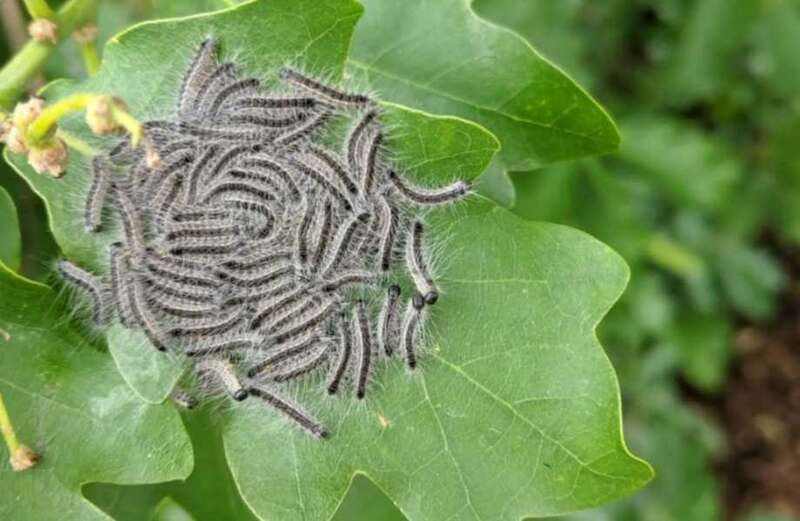AN ARMY of hungry and very toxic caterpillars is on the march - expanding its empire across Britain.
The annual invasion of the caterpillars - the larvae of oak processionary moths (OPM) - has now began in earnest.



The critters first arrived in the UK in a shipment of oak trees from Holland to London in 2006.
But a new map released by the Forestry Commission shows how they have spread to the home counties and beyond in the past 18 years.
Taking Trafalgar Square as the centre of London, the bugs are fully established 26 miles north to Welwyn Garden City, Hertfordshire, and 50 miles south to Dorking in Surrey.
 Spectacular New Year fireworks light up London sky as huge crowds celebrate across UK for first time in three years
Spectacular New Year fireworks light up London sky as huge crowds celebrate across UK for first time in three years
They have also crawled their way 30 miles west to Windsor and Maidenhead in Berkshire, and around 30 miles to the east, almost reaching Southend-on-Sea in Essex.
These four points mark out the 'infected' or 'established' zone - where the pests are already 'bedded in' - which is expanding at around five-miles-a-year.
The surrounding area is called the 'buffer zone', and is where there have been sporadic appearances of the pests.
The buffer zone extends to Bedford to the north, 60 miles from Trafalgar Square, and to Eastbourne and Worthing to the south, around 60-70 miles from the capital.
The zone reaches almost 80 miles to Swindon, Wiltshire, to the west, and almost reaches Canterbury in Kent, 60-odd miles to the east.
Outside these two zones is a 'new zone' - a 'movement exclusion zone' - created last year, which outlaws oak trees being moved out of either the infected or buffer zone in a bid to halt the creepy crawlies.
The rest of the UK shows the 'OPM free areas', which haven't yet had an outbreak.
Forestry Commission bosses found that around 4,000 trees were infested in just under 900 sites in the 'established' and 'buffer' zones in the past year.
More than 5,000 Brits reported the bugs to pest experts, with around 250 reporting being 'attacked' by the caterpillars.
The pests live in and feed off oak trees and are covered in 60,000 hairs, which contain toxins called thamentopoein, which can be 'fired off' to defend themselves.
 Robbie Williams poised to launch his own brand of energy drinks to rival Prime
Robbie Williams poised to launch his own brand of energy drinks to rival Prime
They can cause severe skin rashes and asthma attacks as well as causing eye and throat irritations, vomiting, dizziness and fever.
The oak processionary moth lays its eggs on oak trees and its larvae leave their nests to feed on oak leaves.
Once they have stripped a tree bare they move on to the next tree - following one another in a procession from nose-to-tail, hence their name.
The nests - which are white and the size of a tennis ball - contain hundreds of the creepy-crawlies, which grow to about two-inches long, with caterpillars emerging from late March until mid-July.
May is peak season for them as they reach their full size as they munch their way from one oak tree to another.
The caterpillars go back to their nests in late July where they form a cocoon before being transformed into a moth.
Andrew Hoppit, OPM Project Manager for the Forestry Commission, said it was vital to report the nests and caterpillars as soon as they are spotted.
He said: "It's important that those living in affected areas understand the health risks so that they can be vigilant when enjoying outdoor spaces."
Chiefs at the Forestry Commission say they reckon the critters will have reached Birmingham to the north and Bristol to the west 2035 unless they are stopped.
A £2million budget is in place for experts to set pheromone traps to capture the bugs, but Mr Hoppit said that the UK's 120million oak trees were in 'peril' from the pest.
He said: "These non-native tree pests, first identified in England in 2006, nest on oak trees and eat their leaves, leaving them vulnerable to threats including drought and other pests and diseases.
"OPM caterpillars and their nests are also a hazard to human and animal health."
A spokesman for the Forestry Commission warned people not to approach the caterpillars and to report any nests they find immediately.
He said: "OPM is regulated as a quarantine pest known to be present in Great Britain.
"As a quarantine pest, it is under official control measures and cannot be introduced, moved, multiplied or released without prior authorisation.
"If you suspect you have found an OPM nest or caterpillars, you must report it to us immediately via TreeAlert."
Professor James Pendlebury, the chief exec of Forest Research, said earlier this month that a £4million boost to fund a National Tree Health Laboratory was a ‘great step’ to deal with 'pests'.
He said: "It is important that we increase our capacity to combat these threats so we can continue our world-leading research.
"This investment will help Forest Research fight to safeguard our trees and woodlands for future generations.
"The funding is part of Government action towards its five-year plant biosecurity strategy, which aims to protect the country’s plants from risks posed by pests and pathogens."
Sir William Worsley, Forestry Commission chairman, said: "Trees and woodlands support our wellbeing and are home to some of our most treasured species.
"They play an important role in tackling climate change.
"It is vital that we expand our research to counter new tree health outbreaks which are a threat to our nation's trees."





































